| Contact: | 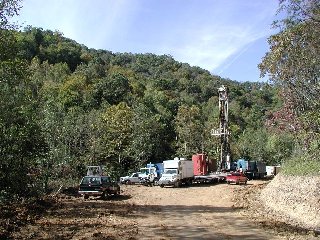
|
This project was funded by the National Energy Technology Laboratory of the U.S. Department of Energy, contract: DE-FC26-02NT41442.
| Contact: | 
|
New Final Report, December, 2005 (5.5 megabyte pdf file)
New Download wells, tops, LAS files (3.7 megabyte zip file)
The final report has been submitted to the Kentucky Geological Survey for publication and will be available in print with a data distribution on CD that will include a Petra project file.
Increased emissions of carbon dioxide (CO2), especially from the combustion of fossil fuels, are being linked to global climate change and are of considerable concern. These concerns are driving initiatives to develop carbon management technologies, including geologic sequestration of CO2. One option for sequestration may be Devonian black shales, organic-rich rocks that are both the source and trap for natural gas (primarily methane). In gas shales, natural gas occurs as free gas in the intergranular and fracture porosity and is adsorbed on clay and kerogen surfaces, very similar to the way methane is stored within coal beds. It has been demonstrated in gassy coals that on average, CO2 is preferentially adsorbed, displacing methane at a ratio of two for one or more. Black shale reservoirs may react similarly and desorb methane in the presence of adsorbing CO2. If this is the case, black shales may serve as an excellent sink for CO2 and have the added benefit of serving to enhance natural-gas production. A bibliography of Devonian shale gas references has been compiled to identify previous work and provide supporting data for continued research.
Drill cuttings collected from recent shale wells were used as the primary material for analyses. The volume of material lost when cuttings were washed dictated a modification of the original sampling protocol; composite cuttings samples were collected before washing. Candidate samples were selected and prepared for total organic carbon, vitrinite reflectance, petrographic, and CO2 adsorption analyses to determine the gas-storage potential of the shale and to identify facies in the shale with the most sequestration potential. For the Devonian shale, average total organic carbon is 3.71 percent (as received) and mean random vitrinite reflectance is 1.16. Columbia Natural Resources (CNR) provided access to a drill hole for collecting sidewall cores and an elemental capture spectroscopy (ECS) logging suite for correlation and mineralogical analysis. To better understand lithology and mineralogy of the shale and the distribution of organic matter, a shale gas analytical model developed by Schlumberger was acquired. The model integrates the standard nuclear log suite and ECS log data. The data from this log analysis and other digital logs were processed to determine TOC and adsorption capacity data.
Samples from the CNR well were submitted for TOC and CO2 adsorption analyses. Additional samples from the New Albany Shale (Illinois Basin) and the Battelle deep well in Mason County, West Virginia (AEP #1) were acquired and submitted for determination of adsorption isotherms. Qualitative X-ray diffraction analyses were conducted to assist in mineral characterization and for correlating results from electron capture spectroscopy logging. In cooperation with Interstate Natural Gas, Pikeville, Kentucky, another ECS log and 10 sidewall cores were acquired for a well in Martin County, Kentucky. The shale gas analytical model developed by Schlumberger was also applied to the logs for this well. Five sidewall core samples were analyzed for quantitative x-ray diffraction, porosity, and permeability. Mineralogically, quantitative x-ray diffraction data from this well average 46% quartz and 39% clay minerals. Phyllosilicate minerals (clays and mica) include Illite, Kaolinite, and Chlorite. As received, porosity averaged 0.9 percent and permeability averaged 0.0005 millidarcys. CO2 adsorption isotherm data using whole rock (not crushed) techniques and data have been received for one of 5 sidewall cores. The reported Langmuir volume is 174.75 scf/ton and the Langmuir pressure is 993.88 psia. Sidewall cores were submitted for methane and CO2 adsorption isotherms and methane displacement analyses. The results of the displacement and flow through experiments are pending.
Adsorption capacity reported as measured Langmuir volumes ranges from 37 to 2,078 standard cubic feet CO2 per ton of shale (scf/ton) at Langmuir pressures ranging from 243 to 14,284 psia. These values represent the range of values for coefficients of the selected Langmuir model. At a constant pressure of 400 psia, the CO2 adsorption capacity ranges from 14 to 136 scf/ton with a median value of 40 scf/ton. Methane adsorption capacity ranges from 2 to 38 scf/ton with a median value of 8 scf/ton. At 400 psia, CO2 adsorption exceeds CH4 adsorption by a factor of 5. These data were correlated with data from nuclear log suites for modeling TOC and CO2 storage capacity for individual wells.
Gamma ray and density log data have been digitized for 18 wells in the Big Sandy Gas field. These data have been correlated and models are being developed to calculate CO2 sequestration capacity as adsorbed gas in place from the shale density log data. ASCII text files of digital log data for 722 wells throughout Kentucky have been converted to log ASCII standard (LAS) format and loaded into mapping software for calculation and spatial analysis of TOC and CO2 adsorption capacity.
Enhanced production of natural gas displaced by CO2 injection remains to be demonstrated; the experiments to investigate enhanced gas recovery from the shale are continuing. These pending flow-through data and the data developed by this project will be expanded in research conducted through the Regional Carbon Sequestration partnerships active in the Illinois and Appalachian Basins. Two-phase dual-porosity reservoir modeling will be used to history match shale gas production and to study CO2 injection. These efforts will result in a better understanding of continuous, low permeability shales as gas reservoirs, sequestration targets, and seals for sequestration.
General conclusions:
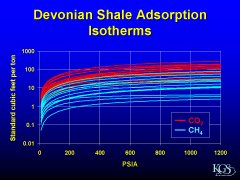 |
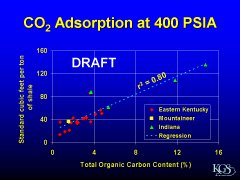 |
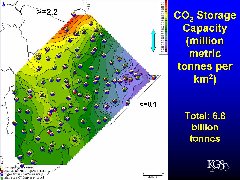 |
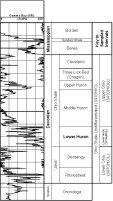 |
| Click to view type geophysical log and Devonian Shale nomenclature used in this study. Close the new window to return to this page. |
Digital files for the CNR 824752 Elk Horn Coal
|
LAS files for the Interstate 3 Jude Heirs
|
| Download wells, tops, LAS files (3.7 megabyte zip file) See 41442_ekywells.pdf and 41442_ekywells.xls in the zip archive for more information. | |
| You must save the files when prompted. Notepad and Excel can be used to view LAS files, but additional software is required to view LAS files in a continuous log presentation (see for example, Schlumberger Dataview). Not all LAS files have track and symbol definitions and may not display what you might consider a "standard" log. For information on the LAS format specification, see the Canadian Well Logging Society. | |
Some PowerPoint presentations have been saved as html and require frames. Some, but not all, presentations include slide notes.